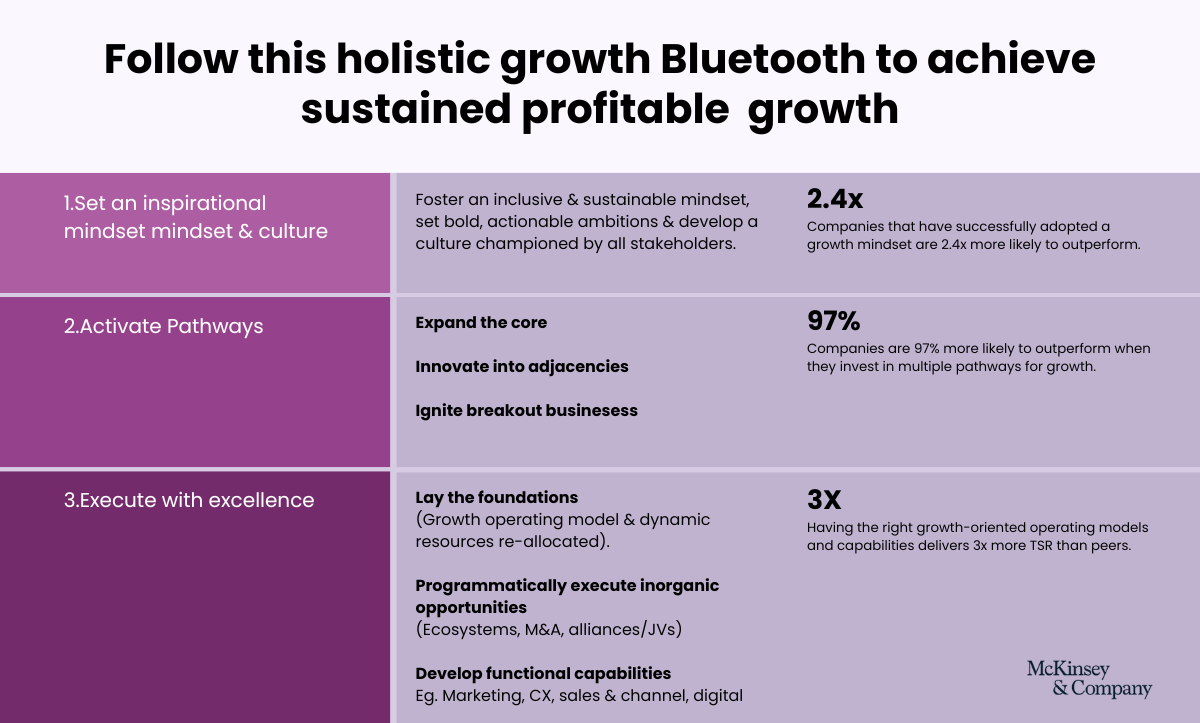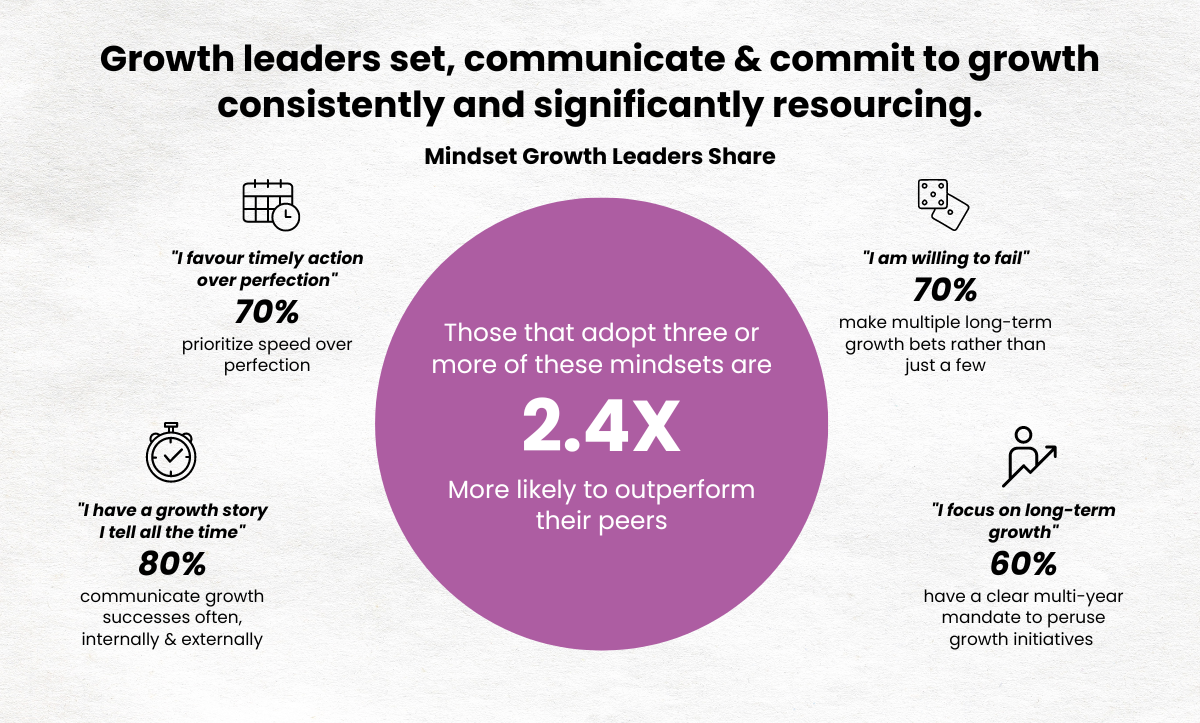
Improve business performance by turning focus to how leaders lead
Change to grow~Mckinsey.
Tell us about a business that doesn’t want to grow its revenue annually. Can you even name one? We doubt it. Did you know that only 1 in 8 companies achieved a 10% growth annually? Growth is something you, as a leader, aspire to deliver but somehow remains elusive.
At any given point, if you want to transform business performance, it can “Never” happen if your leaders aren’t ready to change how they lead. The focus must shift to “what needs to change” if they want to boost organisational health and performance.
Even you will agree that when profitable and inclusive growth becomes a conscious choice, it starts reflecting in the decision-making process across every aspect of the business. Without growth, you won’t be able to replenish oxygen to your organisation, feed culture, elevate ambitions, or inspire a sense of purpose.
In simple words, you will lose talent and innovation. This is why leaders who choose growth align their mindset with strategy and capability, which improves opportunities within and outside the cultures. In fact, if your leaders have a growth mindset, there are 70% more chances to have “growth” as their top priority.
Such leaders follow a timeless blueprint for growth that begins with changing behaviours and mindsets and then leads to execution.

In this article, we will unfold the dynamics around mindset change and how businesses can begin a growth mindset culture that drives revenue.
Also, read: Only 50% of leadership training programs yield the desired results ~ Why?
Maintain the momentum by sticking to a growth mindset
You can’t achieve sustainable and inclusive growth if your leaders aren’t capable of changing themselves. They will have to unlearn years of habits to maintain the momentum and experience continuous long-lasting improvement and business performance.
The time is now that organisations implement a systemic approach to changing the leaders’ behaviours. It’s high time that your leaders align their everyday actions to achieve the company’s targeted results.
Here are three behavioural shifts that your leaders must go through to improve business performance.
- The shift from providing the right answers to asking the right questions
It is the responsibility of an employee to develop their skills for career growth and advancement. But it will become quite challenging if your leaders aren’t motivating or inspiring them to take the necessary steps. However, you can’t share the tips unless you take out time to talk with your teams individually. For this, a continuous feedback system must be in place so that they can offer effective solutions.
Coaching your teams is another way to improve the bottom-line goals. Clearly, this means conversations and communication are important aspects of bringing about change management. Here are four core behaviours that will help leaders ask the right questions.
- Active listening or “listen to understand.”
- Ask powerful questions
- Challenge and support your team
- Establish a roadmap that promotes accountability
You need to understand that your employees must find answers themselves and you should never be at the centre of problem-solving. Your leaders must develop employees that can solve problems and delegate tasks in a way that can focus on strategic tasks that are directly impacting the business growth.
- The shift from looking for instant fixes to finding the root cause of challenges
If you keep solving problems, it will waste the time of the leaders. Further, it will result in creating frustration in employees which will directly impact the organisational profits. Your leaders must adopt a disciplined approach to find the root cause of the problems to keep things moving.
One way to achieve this is to include this as a performance management or development plan process. It will be easier than making it a part of everyday life.
- The shift from setting organisational goals to connect the goals with an individual’s work
You already have a dedicated organisational goal, but it will always look like a far-fetched dream if you don’t follow your individual goals. You need to develop a mindset where your leaders understand how to convert the organisational goals into individual targets. You need to create a mindset where you can link the everyday actions of your teams to the failure and success of overall goals.
In short, growth leaders must allocate resources and take actions that help them achieve goals. The idea is to be more willing to change their operating model, enabling growth whenever required.

But how can organisations develop a roadmap to achieve the growth mindset in leaders? Here are the steps that will help you attain favourable results.
Also, read: What Leadership Skills Should Your Organization Develop?
Steps to improve business performance
1. Identify the behaviours that impact results
You can’t achieve business results if your leaders keep taking the same actions. This is why pinpointing behaviours is important to achieve goals. For instance, organisations can shift from consensus to participative management to reach a decision. You can accomplish this by:
- Involving the right individuals in the decision-making process.
- Listening carefully to the ideas of others.
- Demonstrating acceptance of ideas so that they can repeat the idea generation process.
- Explaining the rationale behind a particular decision.
- Using consequences to reinforce actions to those who believe in the decision and provide feedback to those who disagree with the decision.
Make sure you apply this only for some situations. If you try to make too many changes, it won’t be effective. For instance, leaders can focus on changing one behaviour. That way, implementation will be less challenging and more engaging.
2. Develop a roadmap to shape new behaviours
Often organisations are unable to achieve a mindset change. The sole reason behind such a failure is that organisations don’t identify the gap between current and desired behaviour. Once you identify them, prepare and equip your leaders to shape their mindset so that they can reinforce their performance and delegate tasks effectively.
For instance, if your leaders are used to relying on consensus, it would be challenging to step up and make decisions. Tailored leadership and development programs will allow you to develop leaders who are more adept at decision-making. The idea is to reform the leadership mindset and fill the gap that helps your leaders to be relevant for the “future of work.”
3. Create ways to measure behaviours and successful results
There is no point in learning and changing if it isn’t reflected in the bottom line. This is why you must know whether the programs, coaching, or training are working. You need to set metrics and track your leaders’ progress. For instance, you can go for direct reports, performance reviews, and continuous feedback to find out whether it’s working or not.
4. Keep sticking to goals and results by instilling positive reinforcement
You must understand that old habits are hard to break. This is why if you want to be adept at changing behaviours, you must provide tools to your leaders. For instance, resiliency, skill-based training and motivation will improve the habits. If you also align habit formation with performance perks, it will increase overall returns.
You must replace trial and error methods and develop a roadmap to establish a result-driven approach. This will then be reinforced by policies and adopted by a willingness by all to perform great things.
This roadmap will help your leaders to focus on things that will allow them to grow in the face of timely jolts. It will help you answer a series of questions like:
- Does my mindset encourage growth? Can I align it with organisational growth?
- Am I choosing growth across all aspects of my professional life?
- Am I using the right abilities to grow my aspirations and strategies?
- Am I following the right operating model?
- Am I investing in the right team or capabilities?
You need to make a conscious choice to grow and create powerful momentum which will accelerate business goals and ambitions. It might seem impossible but you can make it possible by taking the right decisions.
What next?
We can help your leaders manage the constant changes brought by new technologies with standalone or group leadership personal branding strategies that will allow them to stay with time, attract trust, build credibility, and boost your brand.
